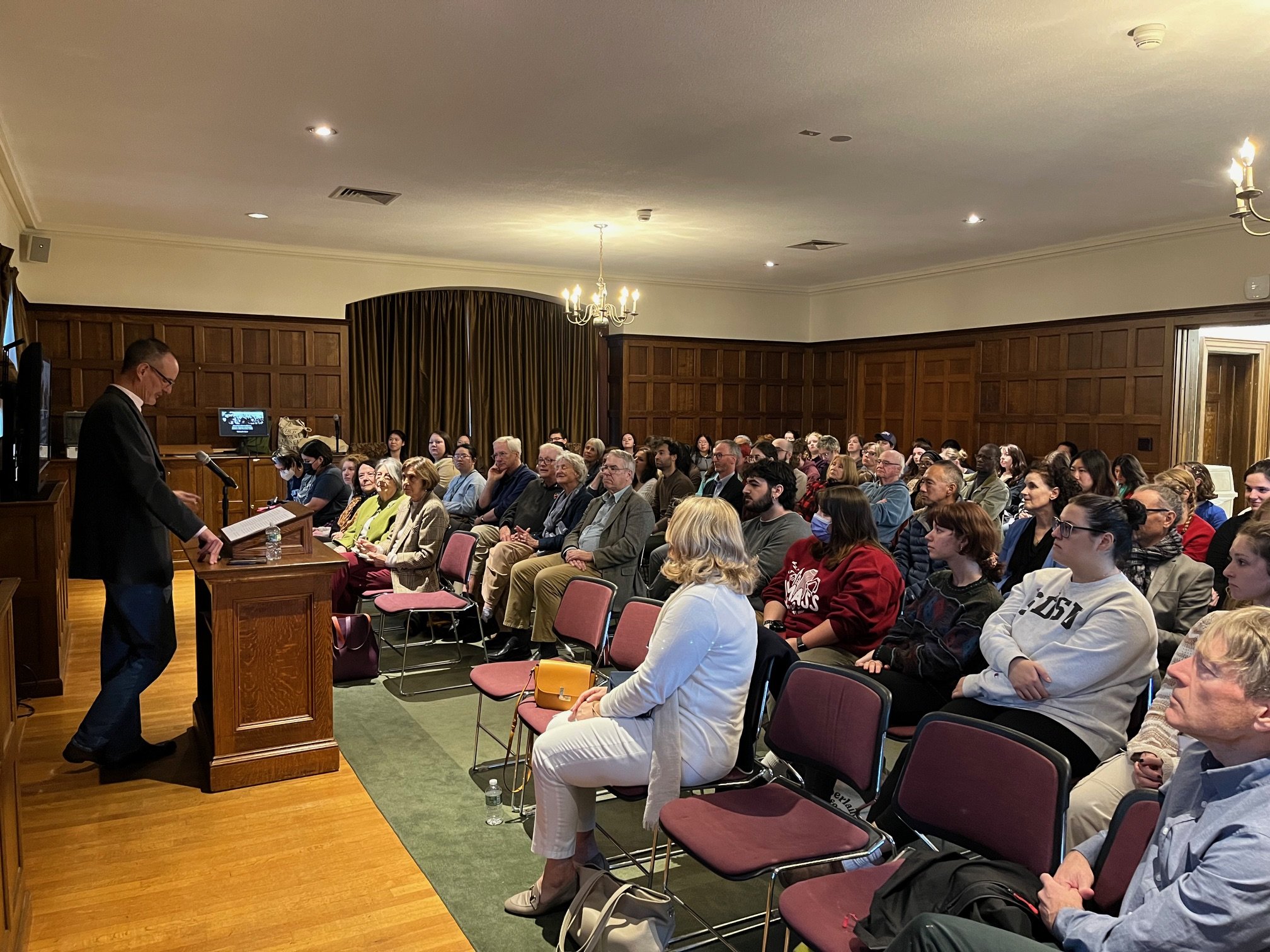Photo courtesy of Ombretta Frau
By Olivia Russo ’25 & Kannille Washington ’28
Staff Writers
Excited members of the Mount Holyoke community and the public crowded into a brimming New York Room on Thursday, Oct. 10 to hear Syracuse University Associate Professor Michael Ebner’s pre-election lecture on Benito Mussolini’s ascension to power.
“Mussolini’s Seizure of Power: Fascism, Violence, and Rhetoric” was an event presented by the Classics and Italian Department and co-sponsored by the McCulloch Center for Global Initiatives and the Valentine Giamatti Fund. Ebner examined the timeline of events that contributed to Mussolini’s rise to dictatorship, including the 1922 March on Rome, the 1924 abduction and murder of Giacomo Matteotti and four different assassination attempts that occurred between 1925 and 1926.
Ebner opened his lecture with a discussion of the March on Rome, during which Mussolini’s armed Blackshirt squads surrounded the city in a massive, coordinated effort to bring the fascists to power. Prior to the attack, Mussolini broadcasted his intentions to attack Rome and secure his rule over Italy, declaring that the government would be given to him or he would “seize it by marching on Rome.”
Afterward, Mussolini had insisted that the march was a peaceful affair, declaring that there was no violence during the march, and the fascists had actually saved Italy from the violence of the left. Here, Ebner introduced a critical idea to the audience: Mussolini was a master at changing the rhetoric he used when speaking about violent acts committed by the fascists, depending on his audience and the political moment.
Plausible deniability was a tool that the dictator often employed in his speeches. On the other hand, when needing to intimidate his opponents, he would associate himself more closely with the violence. Two weeks after the March on Rome, he offered a more threatening account of the event, warning parliamentary deputies that they could have “carried our victory much further.”
Once in power, Mussolini regularly undermined elections. A notable example that Ebner mentioned was the proposal of the Acerbo Law, which gave the party that gained the largest number of votes two-thirds of the seats in Parliament. The law enabled the fascists to seize control of Parliament.
Mussolini also threatened and deployed illegal squad violence. Ebner emphasized the murder of Matteotti, an outspoken socialist against Mussolini, which was orchestrated by fascist operatives. Despite a brief period of anti-fascist sentiment, Mussolini managed to cling to power after the crisis. By then, his squads were organized as official state militia.
During his reign, he also reinstated the death penalty, created political police and set up a tribunal for crimes against the state. Towards the conclusion of his lecture, Ebner detailed four different assassination attempts between 1925 and 1926, all of which inevitably served to strengthen Mussolini’s public image and the dictatorship.
Prior to the lecture, Ebner shared what he hoped to bring to the students. “I think this is stuff that the student body here probably already knows. So I think what this [lecture] is, is really an illustration [that] gives you something to think about, of another historical context.” During the 40-minute Q&A period that took place at the lecture’s conclusion, exchanges between Ebner and an eager audience showcased a mutual understanding for the parallels between Italian fascism and the current political climate of the United States.
Ombretta Frau, the Dorothy Rooke McCulloch professor of Italian at Mount Holyoke, stressed that understanding the how’s and why’s of fascism and political violence — even when studying events that occurred decades ago — is crucial. “I find that it’s important for students to learn because, even though at this point we’re 100 years after the beginning of fascism, which started in 1922 … unfortunately often history repeats itself,” Frau said. She pointed to the current neo-fascist prime minister of Italy as an example.
With election season approaching, mentions during the lecture of pre-election and post-election violence felt particularly relevant for audience members. Though Americans have already witnessed post-election violence in the U.S., such as the Jan. 6 attack on the Capitol in 2021, Frau felt that, “whatever happens in November, it was important to start thinking about the possibility of election violence happening again in this country.”
Ebner builds on this sentiment, shifting the focus from the political violence of the 1920s in Italy towards our own past. Poignantly, he said, “I also want to remind people that, like the United States has a history of violence, of organized violence, of nativism, of white supremacy, of racism, that we don't actually need some Italian guy from the 20s to help us understand we have this in our own history.”
Madeleine Diesl '28 contributed fact-checking.

